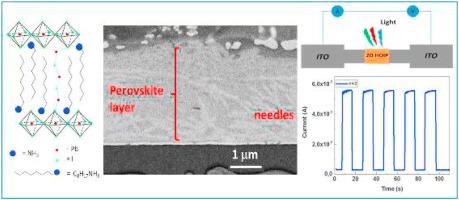Organic Electronics ( IF 3.2 ) Pub Date : 2020-09-21 , DOI: 10.1016/j.orgel.2020.105935 Goutham R. Perumallapelli , Takuya Tsuda , Petr Formanek , Nataliya Kiriy , Vasiliy Bakulev , Frank Simon , Brigitte Voit , Stefan C.B. Mannsfeld , Anton Kiriy

|
This paper reports a comprehensive investigation of 2D and quasi-2D perovskites that are based on rather long-chain octylammonium iodide (OA) and have the a general formula (OA)2(MA)n, PbnI3n+1. Surprisingly, we noticed for 2D and quasi-2D perovskites the presence of significant amounts of the lead state having unusually low binding energy for Pb2+ which resembles unsaturated-valence Pb0 species. The low binding energy of Pb reflects the more electron-rich (compared to 3D counterparts) environment around the Pb centers of the 2D perovskites, which is their inherent property and a consequence of a distinctly different chemical compositions of 2D compared to 3D perovskites. It was found that 2D perovskite-based photodetectors having a lateral arrangement of electrodes show a superior photocurrent yield, compared to quasi-2D (n = 2,3) and 3D (n = ∞) perovskites. Furthermore, 2D and 3D perovskite films exhibit comparable conductivity in the vertical direction, despite of a high content of the insulating component in the OA-based 2D perovskites. The high conductivity was attributed to excellent film-forming properties, high environmental stability as well as favored charge transport morphology of 2D perovskite films. We also propose that inclusions of PbI2 in the organic interlayers may explain the improved charge transportation in these materials. Cross-sectional analysis of the perovskite films and spatially-resolved conductive mode atomic force microscopy measurements support this assumption.
中文翻译:

二维基于碘化铅的钙钛矿结构的新见解
本文报道了对2D和准2D钙钛矿的全面研究,这些钙钛矿基于长链碘化碘化铵(OA),通式为(OA)2(MA)n,PbnI3n + 1。出乎意料的是,我们注意到2D和准2D钙钛矿中存在大量的铅态,其对Pb2 +的结合能异常低,类似于不饱和价Pb0物种。Pb的低结合能反映了2D钙钛矿的Pb中心周围电子富集(与3D对应物相比)的环境,这是它们的固有特性,并且是2D与3D钙钛矿相比化学成分明显不同的结果。已发现,与准2D(n = 2)相比,横向排列电极的2D钙钛矿基光电探测器显示出更高的光电流产量。3)和3D(n =∞)钙钛矿。此外,尽管在基于OA的2D钙钛矿中绝缘成分含量很高,但2D和3D钙钛矿膜在垂直方向上仍具有可比的导电性。高电导率归因于优异的成膜性能,高环境稳定性以及2D钙钛矿薄膜的有利电荷传输形态。我们还提出,有机中间层中包含PbI2可以解释这些材料中电荷传输的改善。钙钛矿薄膜的横截面分析和空间分辨的导电模式原子力显微镜测量结果支持了这一假设。尽管基于OA的2D钙钛矿中绝缘成分含量很高。高电导率归因于优异的成膜性能,高环境稳定性以及2D钙钛矿薄膜的有利电荷传输形态。我们还提出,有机中间层中包含PbI2可以解释这些材料中电荷传输的改善。钙钛矿薄膜的横截面分析和空间分辨的导电模式原子力显微镜测量结果支持了这一假设。尽管基于OA的2D钙钛矿中绝缘成分含量很高。高电导率归因于优异的成膜性能,高环境稳定性以及2D钙钛矿薄膜的有利电荷传输形态。我们还提出,有机中间层中包含PbI2可以解释这些材料中电荷传输的改善。钙钛矿薄膜的横截面分析和空间分辨的导电模式原子力显微镜测量结果支持了这一假设。我们还提出,有机中间层中包含PbI2可以解释这些材料中电荷传输的改善。钙钛矿薄膜的横截面分析和空间分辨的导电模式原子力显微镜测量结果支持了这一假设。我们还提出,有机中间层中包含PbI2可以解释这些材料中电荷传输的改善。钙钛矿薄膜的横截面分析和空间分辨的导电模式原子力显微镜测量结果支持了这一假设。



























 京公网安备 11010802027423号
京公网安备 11010802027423号